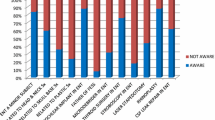Abstract
The Directly Observed Procedural/Practical Skill (DOPS) is a relatively new but reliable tool for formative assessment. The lack of desired awareness regarding DOPS among the Otorhinolayngologists of India made us to conduct this study. The aim of the study was introduction of DOPS in Oto-rhino-laryngology Department. The objectives of the study were: (1) To prepare lists of Oto-rhino-laryngology procedures for DOPS, (2) To conduct Orientation program of DOPS for the participants, (3) To prepare a structured list of items for the rating scale, (4) To facilitate and conduct DOPS encounters of different Oto-rhino-laryngology procedures. The study was conducted in a tertiary care medical college hospital from April 2018 to August 2018. Thirty-three trainees and 5 trainers participated. The 421 DOPS encounters involved 41 Oto-rhino-laryngology procedures. For checking the association between average time and clinical settings and Oto-rhino-laryngology procedures and DOPS encounters, the nonparametric test χ2 test was employed. Male trainees (63.63%) outnumbered female trainees. Mostly trainees (91%) were aged 22–25 years. Approximately half (49%) of the Oto-rhino-laryngology procedures (20/41) and 9/10th (86.22%) of DOPS encounters (363/421) were conducted in OPD. The average time taken to complete the E.N.T. procedures and DOPS encounters was 15 min or less in the majority (91% and 98%) of the Oto-rhino-laryngology procedures (38/41) and DOPS encounters (414/421). DOPS was introduced as a learning tool in the Oto-rhino-laryngology Department of our medical college. For assessing the “competency level” of trainees for E.N.T. procedures, DOPS is a high quality instrument as it tests the candidate at the “does” level.
Similar content being viewed by others

References
Setna Z, Jha V, Boursicot KAM, Roberts TE (2010) Evaluating the utility of work-place assessment tools for specialty training. Best Pract Res Clin Obstet Gynaecol 24:767–782
Norcini J, Burch V (2007) Workplace-based assessment as an educational tool: AMEE Guide No. 31. Med Teach 29:855–871
Morris A, Hewitt J, Roberts C (2006) Practical experience of using directly observed procedures, mini clinical examinations, and peer observation in pre-registration house officer (FY1) trainees. Postgrad Med J 82:285–288
Boursicort K, Etheridge L, Setna Z, Sturrock A, Ker J, Smee S, Sambandam S (2011) Performance in assessment: consensus statement and recommendations from the Ottawa conference. Med Teach 33:370–383
Reforms in Under-graduate and Post-graduate Medical Education (2011) Vision 2015 Medical Council of India. https://www.tnmgrmu.ac.in/images/medical-council-of-india/MCI_book.pdf. Accessed 19 Sept 2018
Kara CO, Mengi E, Tumkaya F, Topuz B, Ardıc FN (2018) Direct observation of procedural skills in otorhinolaryngology training. Turk Arch Otorhinolaryngol 56:7–14
Turnbull J, Gray J, MacFadyen J (1998) Improving in-training evaluation programs. J Gen Intern Med 13:317–323
Wilkinson J, Benjamin A, Wade W (2003) Assessing the performance of doctors in training. BMJ 327:s91–s92
Phillips AW, Madhavan A, Bookless LR, Macafee DA (2015) Surgical trainers’ experience and perspectives on workplace-based assessments. J Surg Educ 72:979–984
Kumar N, Singh NK, Rudra S, Pathak S (2017) Effect of formative evaluation using direct observation of procedural skills in assessment of postgraduate students of obstetrics and gynecology: prospective study. J Adv Med Educ Prof 5:1–5
Hays RB, Davies HA, Beard JD, Caldon LJ, Farmer EA, Finucane PM et al (2002) Selecting performance assessment methods for experienced physicians. Med Educ 36:910–917
Modi JN, Gupta P, Singh T (2015) Competency-based medical education, entrustment and assessment. Indian Pediatr 52:413–420
Awad Z, Hayden L, Muthuswamy K, Ziprin P, Darzi A, Tolley NS (2014) Does direct observation of procedural skills reflect trainee’s progress in otolaryngology? Clin Otolaryngol 39:169–173
Johnson GJ, Barrett J, Jones M, Wade W (2008) Feedback from educational supervisors and trainees on the implementation of curricula and the assessment system for core medical training. Clin Med 8:484–489
Davies H, Archer J, Southgate L, Norcini J (2009) Initial evaluation of the first year of the Foundation Assessment Programme. Med Educ 43:74–81
Thompson WG, Lipkin M et al (1990) Evaluating evaluation: assessment of the American board of internal medicine resident evaluation form. J Gen Intern Med 5:214–217
Acknowledgements
I would like to thank following for their support: Dr. Dimple Mapara Mehta (Dean); Dr. Sanjay Mehta (Academic Dean); Dr. Pankaj Shah (Prof HOD E.N.T.) and Dr. Bhargaw Jadav, Dr. Alaap Shah and Dr. Bhavik Gosai of E.N.T. Department; Dr. Krupal Joshi (PSM Department) of CU Shah Medical College Hospital, Surendranagar, Gujarat.
Author information
Authors and Affiliations
Corresponding author
Ethics declarations
Conflict of interest
The author declares that there is no conflict of interest.
Human and Animal Rights
Research does not involve human participants and/or animals
Additional information
Publisher's Note
Springer Nature remains neutral with regard to jurisdictional claims in published maps and institutional affiliations.
Rights and permissions
About this article
Cite this article
Bansal, M. Introduction of Directly Observed Procedural Skills (DOPS) as a Part of Competency-Based Medical Education in Otorhinolaryngology. Indian J Otolaryngol Head Neck Surg 71, 161–166 (2019). https://doi.org/10.1007/s12070-019-01624-y
Received:
Accepted:
Published:
Issue Date:
DOI: https://doi.org/10.1007/s12070-019-01624-y



